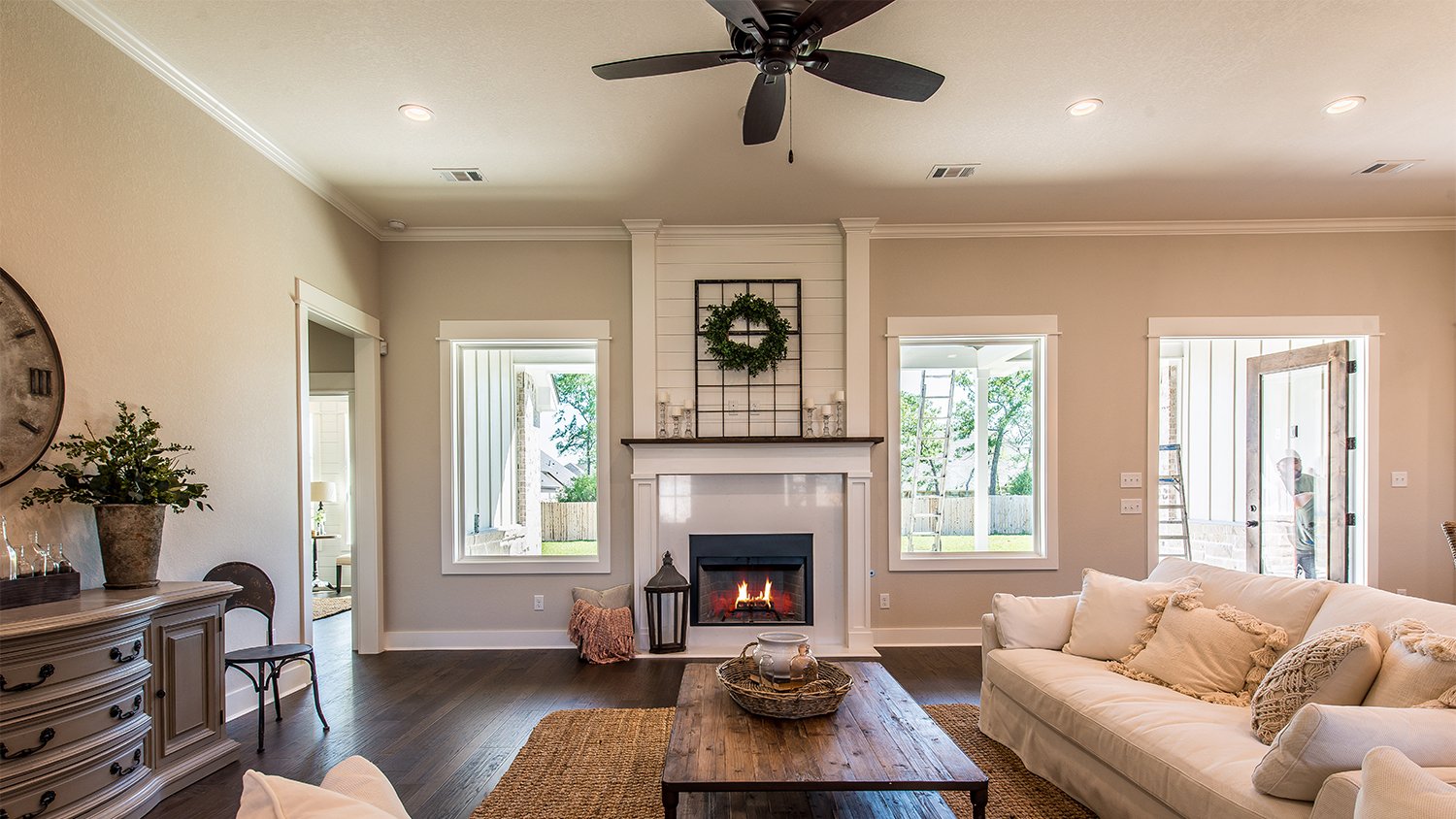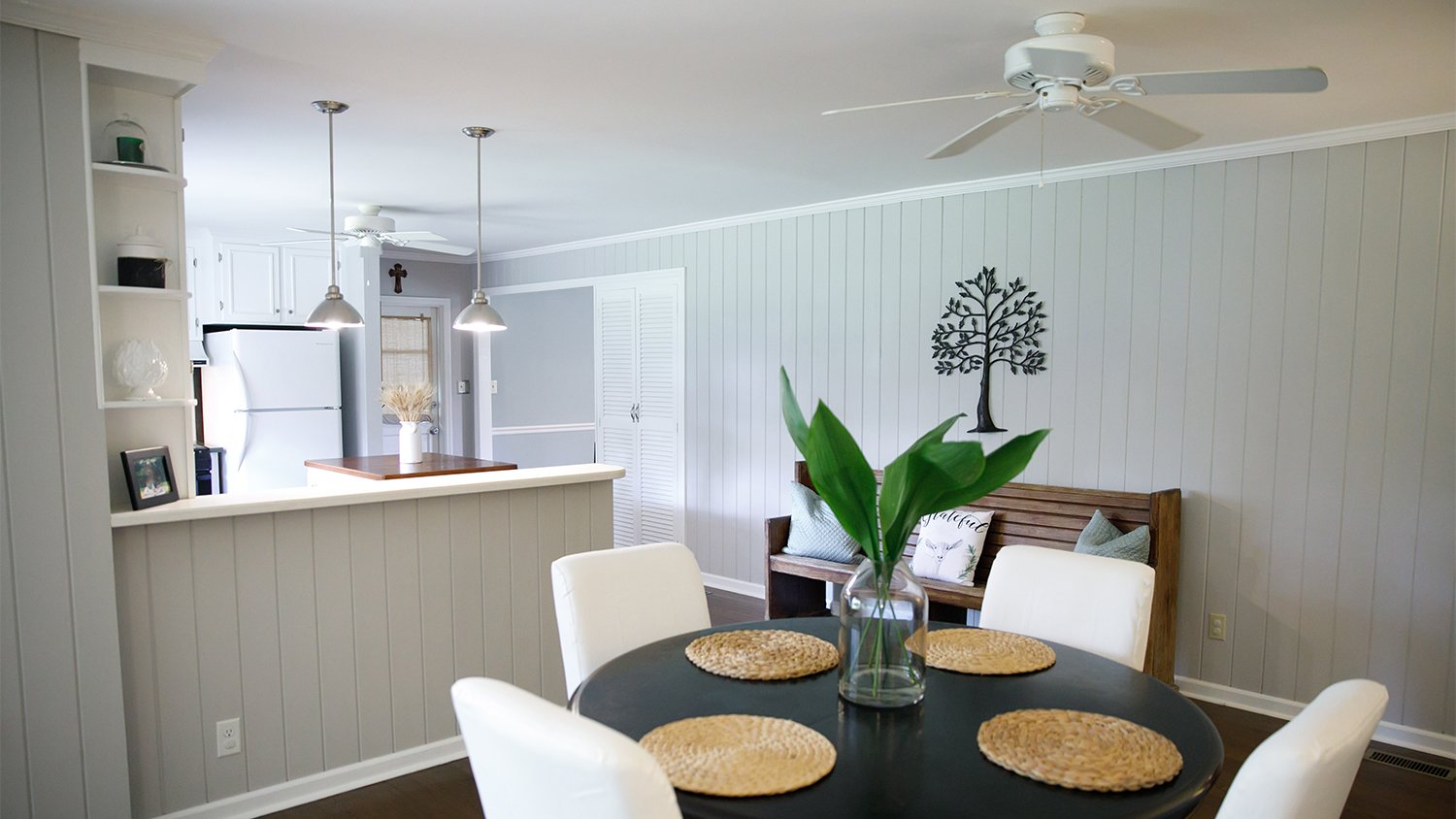7 Types of Ceiling Fans That Will Cool Down Any Room
With the right ceiling fan, you’ll never have to endure a stuffy house again


The ceiling fan that’s right for your home depends on your style, how high the ceilings are, and how breezy you like your space to be. What works for your cozy dining room might not suit your expansive great room. And what about those low ceilings in your basement? Luckily, the ceiling fan industry has covered all possible scenarios by offering a variety of ceiling fan types. Whichever you choose, a ceiling fan professional near you can install your fan to instantly refresh your space.
1. Standard Ceiling Fan

Tried and true, the standard fan is a popular variety of ceiling fan for many traditional homes. And for good reason—they are functional and versatile. Its setup typically includes a blade, motor, and downrod combination, perfect for cooling off any room.
Plus, standard ceiling fans are made from plastic, fiberboard, wood, or metal and will complement all interior decor styles. Feeling like a spruce, but don’t want to buy a new fan? Upgrade your ceiling fan with new light features, modern blades, or colorful paint.
| Pros | Cons |
|---|---|
| Versatile | Hard to clean |
| Cost-effective | May be noisy |
Best For: Indoor spaces with moderate cooling needs
2. Smart Ceiling Fan

From smart door locks to smart thermostats, home automation makes life easier. Why not add an auto fan in the mix? A smart ceiling fan can be controlled with your smartphone or remote control, meaning you don’t have to go far to adjust the fan when things get a bit stuffy.
Smart ceiling fans connect to all your smart devices and “assistants.” On most smart devices, you can even control it with your voice. This is a great option if you have high ceilings, mobility issues, or just want to automate a mundane task.
| Pros | Cons |
|---|---|
| Digital control | Costly |
| Good for high spaces | Hard to clean |
Best For: Rooms with high ceilings and homeowners looking for fans they can control digitally and conveniently
3. Dual Motor Ceiling Fan

Dual motor ceiling fans are ceiling fans with—you guessed it—two motors. They produce more airflow by moving air in multiple directions. You can also set each fan at a different speed to customize the comfort level on either side of the room. These custom features make dual motor ceiling fans ideal for large, public spaces. (You’ve probably seen one in your favorite cafe.)
With their industrial vibe, dual motor ceiling fans are both functional and decorative. Install a ceiling fan over a table in a room with tall ceilings to direct air to the sides instead of directly below the fan. Purchase a light kit to go with it for an added aesthetic touch.
| Pros | Cons |
|---|---|
| High-intensity | Costly |
| Different speeds | Harder to clean |
Best For: Large homes, offices, or public spaces with high cooling needs
4. Energy Star Ceiling Fan
The luxury of a cool breeze can get pretty expensive during the warmer months. Certified Energy Star ceiling fans allow you to reduce your home energy use without sacrificing cooling relief. With efficient motors and blade designs, Energy Star ceiling fans are 60% more efficient than conventional ceiling fans. That means you could save hundreds of dollars on your utility bill over your fan’s lifetime.
To maintain your fixture and ensure it remains as efficient as possible, take steps to balance your ceiling fan regularly.
| Pros | Cons |
|---|---|
| Saves money | Higher cost |
| Energy efficient |
Best For: Indoor spaces with moderate cooling needs and homeowners who are looking for a low-energy solution
5. Low-Profile Ceiling Fan

Sometimes referred to as hugger ceiling fans or flush-mounted ceiling fans, low-profile ceiling fans are among the most popular ceiling fan styles on the market, second to standard ones. Unlike standard ceiling fans, low-profile ceiling fans do not use a downrod. Instead, these curvy delights are flush with the ceiling—perfect in rooms with ceilings under eight feet high.
Low-profile ceiling fans don’t provide the same amount of cooling and airflow as standard ceiling fans because they’re so close to the ceiling, so opt for another variety of ceiling fan if uncomfortably hot summers are common where you live.
| Pros | Cons |
|---|---|
| Good for low ceiling | Reduced airflow |
| Reduced cooling | |
| More headspace | Limited size |
Best For: Basements and other rooms with low ceilings
6. Large Ceiling Fan

If you need a heavy-duty fan to improve air circulation in a massive space, like a lofted great room, a large ceiling fan is ideal. Large ceiling fans work best in spaces with ceilings between 10 to 25 feet high. Turning such weighted blades will require a heavy-duty motor powerful enough to keep open spaces cool and comfortable.
Don’t worry; you won’t have to sacrifice style for function. Many homeowners appreciate larger fans for their eye-catching appearance and modern aesthetic.
| Pros | Cons |
|---|---|
| High cooling | High cost |
| High airflow | Not for small rooms |
| Lots of designs |
Best For: Large rooms with high ceilings and high cooling needs
7. Outdoor Ceiling Fan

Whether you live in a modest cottage, a sweeping mansion, or a tiny apartment, outdoor spaces are treasured square footage. But when lounging on the patio during those warm summer nights starts to feel sticky, turn on an outdoor ceiling fan for some relief.
Damp and wet ceiling fans are outdoor varieties that can withstand soggy and humid conditions. Wet ceiling fans can endure water exposure because they’re completely waterproof. Damp ceiling fans are not completely waterproof but hold up against humidity and moisture just fine.
| Pros | Cons |
|---|---|
| Cooling for outdoor | Noise |
| Waterproof/resistant | High install cost |
Best For: Outdoor spaces like decks and patios where fixtures may get wet
How to Choose the Best Type of Ceiling Fan for Your Home
Finding the right ceiling fan depends on the size and shape of your room and the fan qualities you’re looking for. Consider the height of your ceilings to find a fan that fits properly, then explore features like 3-blade vs. 5-blade ceiling fans to deliver optimal cooling levels.
You can also browse smart fans for accessibility and convenience, as well as energy-friendly options to keep your power bill low and your cooling comfort high.















